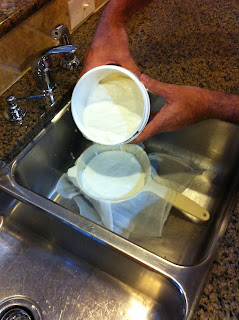Adventures in Cheesmaking
This all started out as a curiosity. Like most stuff we eat there is a rich history behind it. Centuries of experimentation. Cheese is just another example.
From the horse back tribes of the Asian Steppes to the Silk Road camel caravans to Romans Legions to European Monks to today, milk was a great source of nutrition but spoiled quickly and was heavy to transport.
The answer was cheese.
Thursday, December 29, 2011
Fetta - all dressed and ready to eat
Mozzarella - update on microwave method
I made another batch of Mozzarella based on the fast microwave method that I have outlined earlier on this blog. A few extra suggestions:
- Don't use any calcium chloride during production. It is not needed for the acid precipitation and can inhibit the stretching process
- After you start to heat it in the microwave make sure you keep pressing out and removing the whey
- Persist with the heating and kneading. The more you work it the better it gets.
- You will need to wear gloves. The temperature that is needed to get the cheese glossy and stretchy is over 140 F
- I have had a range of problems with the product going slimy on storage. This often happens to Mozzarella and Feta. A few things I have tried include storing in whey, adding a 1/4 teaspoon of citric acid and a few drops of calcium chloride. Mostly this seems to be the result of loss of calcium from the cheese. In fact it is pretty hard to stop and much harder with this fast production method. One solution is to make it as a log and not the traditional balls and vac seal or wrap tightly in cling wrap or store in olive oil.
- Don't use any calcium chloride during production. It is not needed for the acid precipitation and can inhibit the stretching process
- After you start to heat it in the microwave make sure you keep pressing out and removing the whey
- Persist with the heating and kneading. The more you work it the better it gets.
- You will need to wear gloves. The temperature that is needed to get the cheese glossy and stretchy is over 140 F
- I have had a range of problems with the product going slimy on storage. This often happens to Mozzarella and Feta. A few things I have tried include storing in whey, adding a 1/4 teaspoon of citric acid and a few drops of calcium chloride. Mostly this seems to be the result of loss of calcium from the cheese. In fact it is pretty hard to stop and much harder with this fast production method. One solution is to make it as a log and not the traditional balls and vac seal or wrap tightly in cling wrap or store in olive oil.
Neufchâtel - a US take on a classic
| French Neufchatel - note the bloomy rind similar to Camembert |
The US version is a very different product.
Various references suggest that in 1872, while marking Neufchatel with lower fat milk a William Lawrence of Chester, New York produced a cream cheese alternative - what every the exact history the US product is most defiantly not Neufchatel but is most defiantly delicious.
Eaten fresh (0-2 weeks) this is a mildly fermented soft and creamy cheese that is ideal for use as a spread or as a replacement for cream cheese. What I like about it is that it has a lower fat level and a slightly fuller taste that cream cheese. This one was based on whole milk at 3.5% butterfat rather than cream at 12-18% butterfat.
The process is interesting in that the milk is fermented at a low temperature (room temp) for up to 24 hours and then drained for a similar time - the result is a soft and creamy cheese with a mild flavor that continues to develop and firm across time.
Ingredients
1/2 gallon whole organic milk
1/16 tsp mesophilic direct set starter
10 drops calcium chloride
10 drops double strength liquid rennet
cheese cloth
1 tablespoon cheese salt
Optional
colander
pH strips
cheese mat
yogurt maker
herbs
Method
 |
| Dilute and add rennet and calcium chloride, add mesophilic starter and stir for 3 minutes |
 |
| Transfer to a yogurt maker or a container that will allow the milk to ferment at 70 F |
 |
| Ferment for 24 hours, a soft curd had formed , similar to a firm set yogurt |
 |
| The pH of the curd was 4.5-5.0 |
 |
| Line a colander with cheese cloth and add curds |
 |
| AT 24 hours the curds had drained |
 |
| Unwrap curds, place ion a bowel and add a tablespoon of cheese salt, mix well |
 |
| Add herbs and form into logs or balls. The cheese is very creamy. I found that forming it in cling wrap into logs , with the use of a draining mat or into balls helped. |
Subscribe to:
Comments (Atom)



